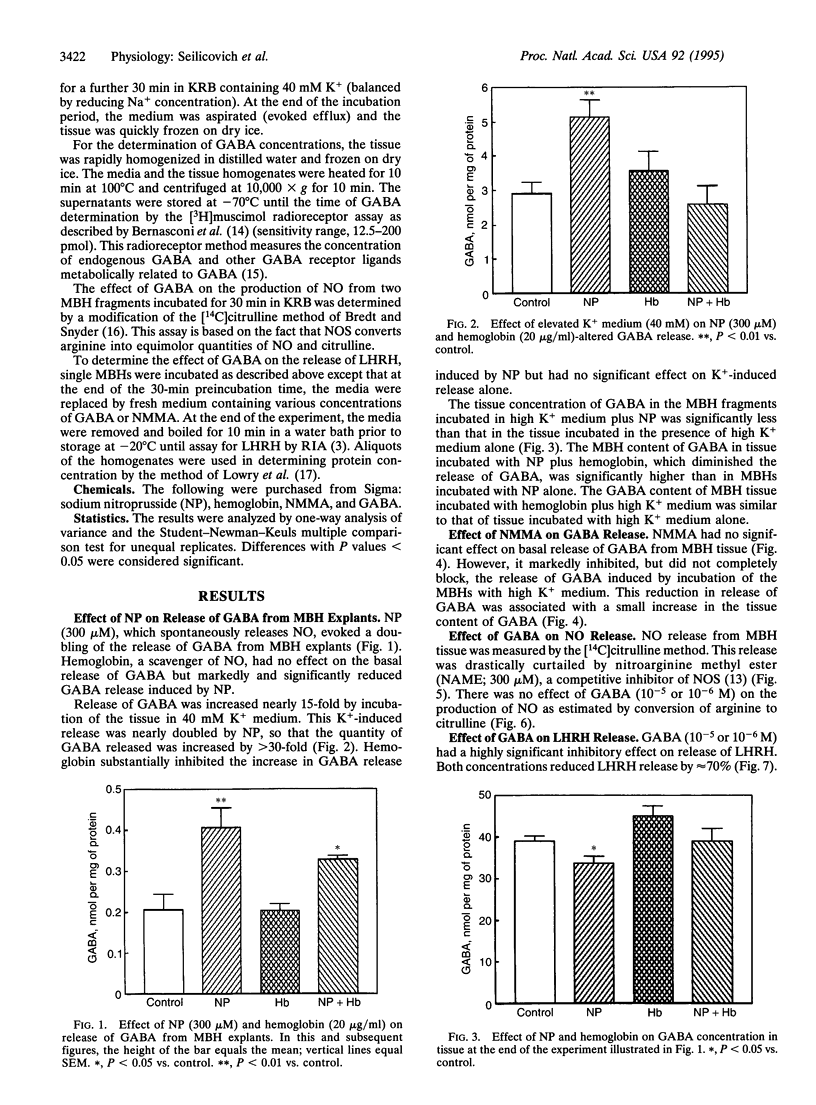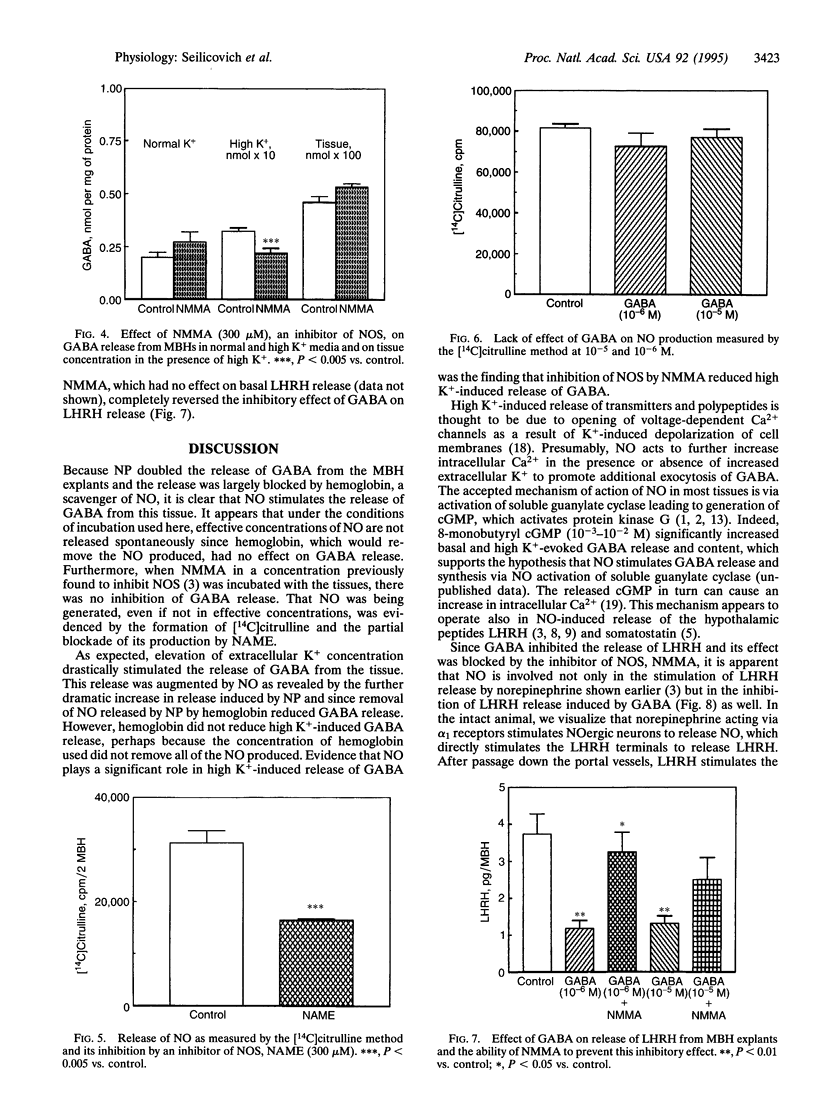Abstract
Nitric oxide synthase (NOS)-containing neurons, termed NOergic neurons, occur in various regions of the hypothalamus, including the median eminence-arcuate region, which plays an important role in controlling the release of luteinzing hormone-releasing hormone (LHRH). We examined the effect of NO on release of gamma-aminobutyric acid (GABA) from medial basal hypothalamic (MBH) explants incubated in vitro. Sodium nitroprusside (NP) (300 microM), a spontaneous releaser of NO, doubled the release of GABA. This release was significantly reduced by incubation of the tissue with hemoglobin, a scavenger of NO, whereas hemoglobin alone had no effect on the basal release of GABA. Elevation of the potassium concentration (40 mM) in the medium increased GABA release 15-fold; this release was further augmented by NP. Hemoglobin blocked the increase in GABA release induced by NP but had no effect on potassium-induced release, suggesting that the latter is not related to NO. As in the case of hemoglobin, NG-monomethyl-L-arginine (NMMA), a competitive inhibitor of NOS, had no effect on basal release of GABA, which indicates again that NO is not significant to basal GABA release. However, NMMA markedly inhibited the release of GABA induced by high potassium, which indicates that NO plays a role in potassium-induced release of GABA. In conditions in which the release of GABA was substantially augmented, there was a reduction in GABA tissue stores as well, suggesting that synthesis of GABA in these conditions did not keep up with release of the amine. Although NO released GABA, there was no effect of the released GABA on NO production, for incubation of MBH explants with GABA had no effect on NO release as measured by [14C]citrulline production. To determine whether GABA had any effect on the release of LHRH from these MBH explants, GABA was incubated with the tissue and the effect on LHRH release was determined. GABA (10(-5) or 10(-6) M) induced a 70% decrease in the release of LHRH, indicating that in the male rat GABA inhibits the release of this hypothalamic peptide. This inhibition in LHRH release induced by GABA was blocked by NMMA (300 microM), which indicates that GABA converts the stimulatory effect of NO on LHRH release into an inhibitory one, presumably via GABA receptors, which activate chloride channels that hyperpolarize the cell. Previous results have indicated that norepinephrine stimulates release of NO from the NOergic neurons, which then stimulates the release of LHRH. The current results indicate that the NO released also induces release of GABA, which then inhibits further LHRH release. Thus, in vivo the norepinephrinergic-driven pulses of LHRH release may be terminated by GABA released from GABAergic neurons via NO.
Full text
PDF



Selected References
These references are in PubMed. This may not be the complete list of references from this article.
- Aguila M. C. Growth hormone-releasing factor increases somatostatin release and mRNA levels in the rat periventricular nucleus via nitric oxide by activation of guanylate cyclase. Proc Natl Acad Sci U S A. 1994 Jan 18;91(2):782–786. doi: 10.1073/pnas.91.2.782. [DOI] [PMC free article] [PubMed] [Google Scholar]
- Bedran de Castro J. C., Khorram O., McCann S. M. Possible negative ultra-short loop feedback of luteinizing hormone releasing hormone (LHRH) in the ovariectomized rat. Proc Soc Exp Biol Med. 1985 May;179(1):132–135. doi: 10.3181/00379727-179-1-rc2. [DOI] [PubMed] [Google Scholar]
- Bernasconi R., Bittiger H., Heid J., Martin P. Determination of GABA levels by a [3H]muscimol radioreceptor assay. J Neurochem. 1980 Mar;34(3):614–618. doi: 10.1111/j.1471-4159.1980.tb11188.x. [DOI] [PubMed] [Google Scholar]
- Bredt D. S., Hwang P. M., Snyder S. H. Localization of nitric oxide synthase indicating a neural role for nitric oxide. Nature. 1990 Oct 25;347(6295):768–770. doi: 10.1038/347768a0. [DOI] [PubMed] [Google Scholar]
- Bredt D. S., Snyder S. H. Isolation of nitric oxide synthetase, a calmodulin-requiring enzyme. Proc Natl Acad Sci U S A. 1990 Jan;87(2):682–685. doi: 10.1073/pnas.87.2.682. [DOI] [PMC free article] [PubMed] [Google Scholar]
- Bredt D. S., Snyder S. H. Nitric oxide mediates glutamate-linked enhancement of cGMP levels in the cerebellum. Proc Natl Acad Sci U S A. 1989 Nov;86(22):9030–9033. doi: 10.1073/pnas.86.22.9030. [DOI] [PMC free article] [PubMed] [Google Scholar]
- Karanth S., Lyson K., McCann S. M. Role of nitric oxide in interleukin 2-induced corticotropin-releasing factor release from incubated hypothalami. Proc Natl Acad Sci U S A. 1993 Apr 15;90(8):3383–3387. doi: 10.1073/pnas.90.8.3383. [DOI] [PMC free article] [PubMed] [Google Scholar]
- Knowles R. G., Palacios M., Palmer R. M., Moncada S. Formation of nitric oxide from L-arginine in the central nervous system: a transduction mechanism for stimulation of the soluble guanylate cyclase. Proc Natl Acad Sci U S A. 1989 Jul;86(13):5159–5162. doi: 10.1073/pnas.86.13.5159. [DOI] [PMC free article] [PubMed] [Google Scholar]
- LOWRY O. H., ROSEBROUGH N. J., FARR A. L., RANDALL R. J. Protein measurement with the Folin phenol reagent. J Biol Chem. 1951 Nov;193(1):265–275. [PubMed] [Google Scholar]
- Mahachoklertwattana P., Black S. M., Kaplan S. L., Bristow J. D., Grumbach M. M. Nitric oxide synthesized by gonadotropin-releasing hormone neurons is a mediator of N-methyl-D-aspartate (NMDA)-induced GnRH secretion. Endocrinology. 1994 Oct;135(4):1709–1712. doi: 10.1210/endo.135.4.7523101. [DOI] [PubMed] [Google Scholar]
- Masotto C., Wisniewski G., Negro-Vilar A. Different gamma-aminobutyric acid receptor subtypes are involved in the regulation of opiate-dependent and independent luteinizing hormone-releasing hormone secretion. Endocrinology. 1989 Jul;125(1):548–553. doi: 10.1210/endo-125-1-548. [DOI] [PubMed] [Google Scholar]
- McCann S. M., Rettori V. Gamma amino butyric acid (GABA) controls anterior pituitary hormone secretion. Adv Biochem Psychopharmacol. 1986;42:173–189. [PubMed] [Google Scholar]
- Mitchell R., Grieve G., Dow R., Fink G. Endogenous GABA receptor ligands in hypophysial portal blood. Neuroendocrinology. 1983 Sep;37(3):169–176. doi: 10.1159/000123539. [DOI] [PubMed] [Google Scholar]
- Moretto M., López F. J., Negro-Vilar A. Nitric oxide regulates luteinizing hormone-releasing hormone secretion. Endocrinology. 1993 Nov;133(5):2399–2402. doi: 10.1210/endo.133.5.8104781. [DOI] [PubMed] [Google Scholar]
- Rettori V., Belova N., Dees W. L., Nyberg C. L., Gimeno M., McCann S. M. Role of nitric oxide in the control of luteinizing hormone-releasing hormone release in vivo and in vitro. Proc Natl Acad Sci U S A. 1993 Nov 1;90(21):10130–10134. doi: 10.1073/pnas.90.21.10130. [DOI] [PMC free article] [PubMed] [Google Scholar]
- Rettori V., Belova N., Gimeno M., McCann S. M. Inhibition of nitric oxide synthase in the hypothalamus blocks the increase in plasma prolactin induced by intraventricular injection of interleukin-1 alpha in the rat. Neuroimmunomodulation. 1994 Mar-Apr;1(2):116–120. doi: 10.1159/000097144. [DOI] [PubMed] [Google Scholar]
- Rettori V., Belova N., Yu W. H., Gimeno M., McCann S. M. Role of nitric oxide in control of growth hormone release in the rat. Neuroimmunomodulation. 1994 May-Jun;1(3):195–200. doi: 10.1159/000097160. [DOI] [PubMed] [Google Scholar]
- Rettori V., Kamat A., McCann S. M. Nitric oxide mediates the stimulation of luteinizing-hormone releasing hormone release induced by glutamic acid in vitro. Brain Res Bull. 1994;33(5):501–503. doi: 10.1016/0361-9230(94)90074-4. [DOI] [PubMed] [Google Scholar]
- Rettori V., Kamat A., McCann S. M. Nitric oxide mediates the stimulation of luteinizing-hormone releasing hormone release induced by glutamic acid in vitro. Brain Res Bull. 1994;33(5):501–503. doi: 10.1016/0361-9230(94)90074-4. [DOI] [PubMed] [Google Scholar]
- Tan K. N., Tashjian A. H., Jr Voltage-dependent calcium channels in pituitary cells in culture. I. Characterization by 45Ca2+ fluxes. J Biol Chem. 1984 Jan 10;259(1):418–426. [PubMed] [Google Scholar]
- Valtschanoff J. G., Weinberg R. J., Kharazia V. N., Schmidt H. H., Nakane M., Rustioni A. Neurons in rat cerebral cortex that synthesize nitric oxide: NADPH diaphorase histochemistry, NOS immunocytochemistry, and colocalization with GABA. Neurosci Lett. 1993 Jul 23;157(2):157–161. doi: 10.1016/0304-3940(93)90726-2. [DOI] [PubMed] [Google Scholar]
- Xu X., Star R. A., Tortorici G., Muallem S. Depletion of intracellular Ca2+ stores activates nitric-oxide synthase to generate cGMP and regulate Ca2+ influx. J Biol Chem. 1994 Apr 29;269(17):12645–12653. [PubMed] [Google Scholar]


